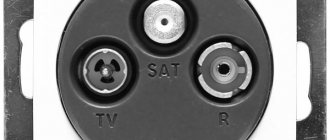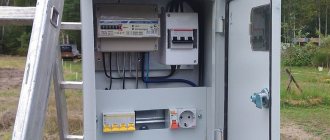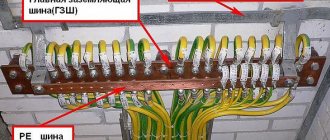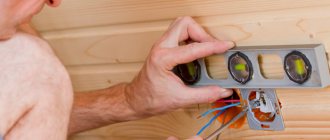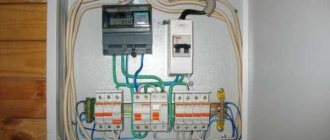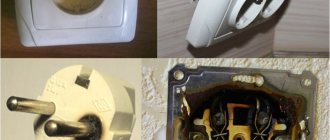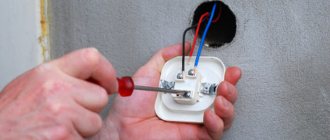Types of sockets
Three-phase sockets come in various types, shapes and functionality, the main options are listed below:
- Stationary 4 contacts . They include a surface-mounted or built-in 380 V socket and plug, such as are usually used to power a household electric stove and allow you to connect 3 phases and one common zero;
- Stationary with five contacts are used to connect a five-core electrical cable: 3 phases, common and protective zero. Available with varying degrees of dust and moisture protection and installed on a flat surface. The most popular maximum current range is from 16 A to 40 A. The plugs have the appropriate number of pins, and they also have a structural spike that is inserted into the groove of the socket, thereby eliminating incorrect docking.
If a detachable connection of the electrical cable is necessary, a three-phase wall-mounted socket is used. For the most part, they are used outdoors or in wet areas and have IP54. For particularly severe operating conditions, manufacturers produce connectors with an increased degree of IP67, which work even under water.
- There are also 3-phase sockets that can withstand much larger current loads of up to 125 amperes and higher. Such connectors are used to power powerful industrial equipment. As a rule, such power places increased demands on protection: most devices are marked IP67.
Types of 380 volt outlets
Today there are a large number of modifications of 380 volt outlets. First of all, let's look at their types. It is important to note that the connection method directly depends on its modification, so we will identify the existing modifications.
To begin with, it is worth noting that the 380 volt outlet is used in a three-phase system. By this we mean that three wires are used and each of them is a phase. As for the voltage between these wires, it is 220 V. That is, this is phase voltage. As a rule, this is the voltage that is supplied to our apartments and private houses for servicing household appliances. For this purpose, it is enough to start one phase, where there is a neutral wire and a phase.
As for the voltage between the phase wires, it is 380 volts. It is also called linear. That is, you can get 380 volts in the network if you use two phase wires, and not all three at the same time. A large number of electrical installations have a two-phase connection, for example, this method is used in an electric stove. Also, a two-phase connection is required in other equipment.
Important! Any network with 380 volts must have a grounding conductor according to established requirements. In its absence, there is a high risk of electric shock to a person when it comes into contact with the body of electrical equipment.
So, now we offer several types of 380-volt outlets, which are often connected in private homes.
380V 2P+PE
This type of outlet has two phases. It also has power contact. Plus, there is a grounding contact.
380V 3P+PE
This type of socket is equipped with three power contacts. Plus, there is one grounding contact.
380V 3P+PE+N
There are three contacts here, through which three phases can be connected. One contact is provided for the grounding cable. There is also a contact for the neutral wire.
380V 3P+N
This is a combined option that includes both a socket and a plug. As for its features, it is a complete analogue of the 3P+PE configuration. It is no different from this model. And the fact that it is offered for sale as separately is determined only by the presence of a plug.
Connection diagrams
On many modern connectors you can find symbols that help facilitate wiring. Phases in most cases are designated as follows: L1, L2, L3, zeros: common - N, protective - PE or ground symbol.
Consider connecting a three-phase socket with 4 contacts.
After the electricity meter, a four-pole circuit breaker is installed, to which three phases and a neutral wire are suitable. When the permissible current values are exceeded, the machine turns off all phases and the neutral wire, thereby neutralizing the negative consequences of overloads and protecting the circuit from short circuits. The protective zero bus can be connected directly to the consumer.
In the case of a three-phase socket with five contacts, the connection diagram is similar, the main difference is that the PE is supplied directly to the socket.
If you install an RCD (Residual Current Device) instead of a circuit breaker, this will increase the safety of a person working with equipment. If a leak occurs on the housing, the RCD will automatically turn off the power. Thus, the risk of electric shock is minimized.
Connecting wires to connectors
In industrially produced installation products, 2 types of clamps are used:
- screw,
- self-clamping.
In the first option, the bare end of the wire is installed in a special socket and held there with a tightened screw. This method has been used for a long time, but over time the fastenings weaken and it is necessary to periodically check the connection of cable cores and terminals.
The second option is relatively new. It not only saves the time required to disconnect cable products, but also eliminates poor-quality tightening of terminals. At the same time, the connection reliability is higher.
The order of connecting the wires is as follows:
- The braided cores are inserted into the clamp until it stops;
- then a slotted screwdriver is inserted into a special groove and lifted slightly, allowing the entire movable structure to be fixed inside the socket body. In this case, the insulation is cut and the wire is secured, thereby ensuring reliable electrical contact with the terminal of the three-phase socket;
- Once the fixation is complete, the screwdriver is removed.
Installation and connection
When answering the question “How to connect a 380 Volt outlet,” first of all, it is worth saying that there are two methods of connecting the wire and the product - screw fastening and screwless fastening.
Connecting a power outlet with your own hands should begin by turning off the electricity. You also need to determine which cable does what. When using the first connection method, screw, pay attention to the back of the product - there are special screws that secure the wire. This method is popular, but a lot of time is spent preparing the cables and securing them in the socket.
The most common designation is that phases are marked with the letter L, a standard symbol is used for “ground,” and N indicates the connection of the working zero.
With screwless fastening, you can save some time and avoid some mistakes. Despite this, with proper connection, reliability remains at a high level. For installation there is no need to strip the contacts - they will be pierced in the groove.
Here we have described the most common product options. Of course, there are some sockets with non-standard connections, but in this case, it is better to consult the seller. If difficulties or questions arise, we recommend that you study the proposed diagrams for connecting the outlet, which will greatly simplify the process.
- The role of video surveillance systems in security
- How to arrange a kitchen corner?
- Silicone tube. What it is?
Socket installation
Let's look at the procedure for connecting three-phase sockets using the example of an ABB socket.
- First, we disassemble the socket into its component elements by unscrewing a couple of mounting screws on the front. It consists of a base (base), a cover, an O-ring with a 20 mm hole and a socket mechanism; in addition, the kit includes a rubber gland for hidden connection of wiring from the wall or for bringing cables inside without corrugation.
- First you need to fix the base in the selected location. Why do we place the base against the wall, leveling it in place using a level. Then, using a simple pencil, we make marks at the locations of the mounting holes. If the wall is wood or plaster, then the base can be immediately secured with self-tapping screws. If the wall is brick or concrete, then first use a puncher to make holes with a diameter of 6-8 mm, into which dowels of the appropriate diameter are installed, and then the base is secured by screwing in the screws.
- Then prepare the power cable. To do this, insert the corrugation into the gland 1-2 cm, and pull the cable another 9-10 cm inside the housing.
- Next, remove the general protective sheath, leaving 25-30 mm, and expose the ends of the wires by 10-12 mm. In this case, the protective grounding conductor is made slightly shorter than the others, but more insulation is cut off from it.
- After the manipulations have been carried out, insert the ends of the wires into the appropriate places according to the markings and fix them with a screwdriver.
- The next step is to check the reliability of the cable fastening and correct assembly, close the cover and tighten the screws.
- As a result, after simple steps, the device is ready for use.
Connection methods
Power cable VVGng(A)-LS
High voltage is dangerous to life, so safety precautions and connection rules should not be neglected.
The basis of any connection is the cable. It is important to choose the correct section that is suitable in size and can withstand the potential load. According to GOST, for a socket with a voltage of 380V and a current of 16 A, a wire with a cross-section of 1.5 to 4 mm is sufficient. The plug cable must be a minimum of 1.5 and no more than 2.5 mm. The thickness of the grounding wire should be 6 mm.
When installing switching elements, it is important to use the rule: supply cable - socket, receiving cable - plug. When stripping the wire, do not allow the wire to break off or become tangled. The more uniform the contact part of the cable is, the better the transmission and the less overheating.
Four-wire networks
Installation of wires begins with disassembling the housing. The 380 volt switch socket has 4 contacts, three of which are phase. Near the contacts you need to find the designations L1 L2 L3 and connect three phase wires to them in random order. Next, you need to find the neutral wire and clamp it to the terminal marked with the letter N.
Five-wire networks
When connecting a connector with five contacts, a scheme similar to the previous one is used. The designation near the contact pads is the same: L1 L2 L3 - phase, N - zero and PE - ground wire. The presence of earth requires an additional circuit element - an RCD. This connection will prevent electric shock if the housing or mounting rail is energized.
Connecting a three-phase socket
The connection can occur either with or without the use of an RCD. It all depends on the presence of a protective grounding cable. The connection is symmetrical, so the order of connecting the power cables is arbitrary. At the end of installation work, you should check the correct connection and correct errors.
Installation check
After installing a three-phase outlet, before starting operation, always check the circuit for errors.
For most devices, phases to a plug or socket can be connected to any terminals, except those intended for working and protective cables.
In some cases, some equipment with three-phase motors will not work correctly, because... The direction of rotation of the engine will be opposite. For normal operation, any two wiring with phases should be interchanged with each other.
At the same time, if you confuse the connections of the working and protective zero, this can lead to dire consequences: the protection against short circuit and electric shock will be disrupted, and there will be a risk of using the electrical installation.
Immediately after completion of installation work, perform the following actions: Carry out a thorough inspection of all contacts for their reliability. Measure the parameters of the insulation resistance of the cores.
The insulation resistance is checked with a multimeter or tester.
To do this you need:
- One probe is placed on the terminal with the protective wire, the other touches the remaining terminals in turn.
- The first probe is placed on the terminal with the working zero, the second is alternately passed along the contacts with the phases.
- One probe is applied to the phase point, the other is carried out along the remaining phases.
- Check the remaining phases.
If during any test there is a small resistance, this indicates an installation error or a malfunction of the wiring itself. If everything is done correctly, there will be a dash on the dial of the device, indicating a very high resistance. Only under this condition can the position of the machine petal be moved to “ON”.
Checking sockets
Before operation, it is important to do a check, which consists of four main points:
- Visual inspection for possible physical defects in the housing.
- If you have a megohmmeter, the strength of the insulating coating is checked. During diagnostics, the 380 volt outlet must be de-energized.
- A short circuit is created using the device to check the correct connection.
- Measurement of linear and phase voltage at idle.
During testing, the operating voltage between phases should be no more than 380V and 220V on one core. At the end, you should once again check the correctness and quality of the connection. A poorly tightened contact will overheat and fail, damaging the housing.
If the circuit opens, an arc may occur, creating a danger to life and risk of failure. To avoid this phenomenon, always turn off the power supply before dismantling. More expensive versions have an automatic transmission.
During operation, the wires heat up and expand. As a result, the screw connections become loose, resulting in poor contact. All wires must be re-tightened every year.
Connecting a 380 volt plug
In one of the recent articles, I already talked about connecting a 380 Volt socket - ABB 416RS6, made according to the specifications of the International Electrotechnical Commission, IEC 60309 and used everywhere for connecting three-phase electrical equipment. Now it’s the turn to talk about the 380V electrical plug, made according to the same standard, which can actually be connected to this connector.
ABB 416-p6 is a portable three-phase cable plug, with a degree of protection IP44, rated for a current of 16A, having the following contacts - 3P+N+E (three phases, working zero and protective zero - grounding).
As an example, we will install this three-phase plug on a professional stationary high-pressure washer - Portotecnica ML CMP 2860 T.
This high-pressure apparatus is based on a three-phase asynchronous motor, the connection of which does not require a working zero (or simply ZERO, as we used to call it), only three phases and a protective zero (grounding) are enough, which is connected to the body and other conductive parts of the sink . uh
Accordingly, the delivery set of this sink includes only a four-core cable; it does not contain a neutral cable.
Voltage check
Power parameters are determined with a multimeter or voltmeter. Between any phase contacts the readings are about 380 V, between the working zero and the phases the voltage is 220 V, between the protective zero and the phases it is also about 220 V. If all the indicated numbers match, then the three-phase socket is ready for use.
Thus, you can independently supply power to a three-phase outlet or eliminate small faults associated with such equipment, avoiding errors associated with connecting the cable.
CONNECTING A 380V THREE-PHASE PLUG
We begin the installation by disassembling the ABB power plug into its component parts. To do this, you do not need to unscrew any additional bolts or screws, just turn the top, red part of the fork counterclockwise. In total, a 380-volt plug consists of three main components:
– Mechanism
– Protective housing
– A cable clamp designed for hermetically sealed entry of the power cable into the plug.
The cable clamp and protective housing of the ABB three-phase plug must be placed on the power cable of the device, as shown in the image below. Put on in the reverse order, namely, first the cable clamp, and then the protective housing.

